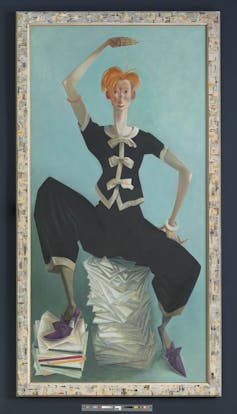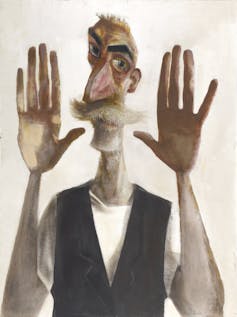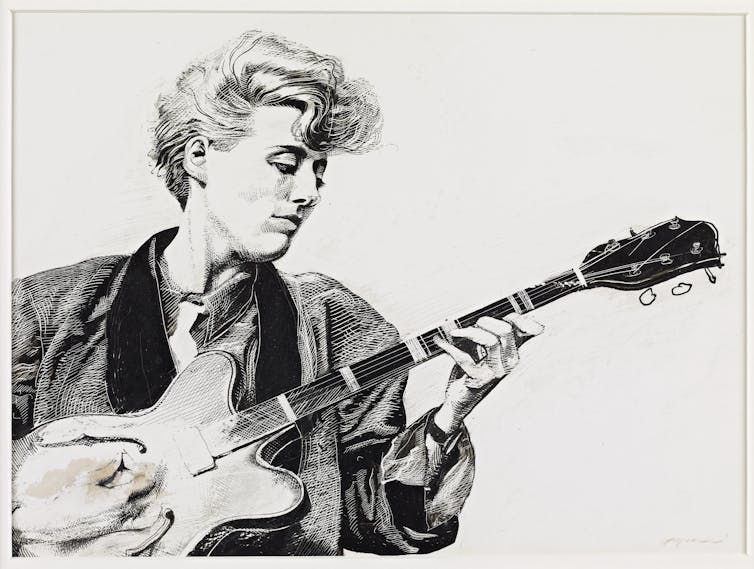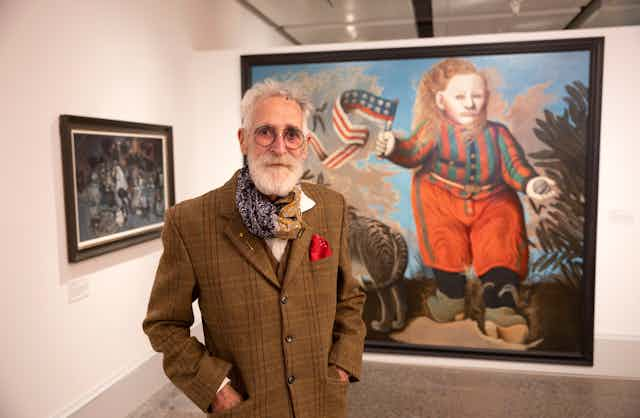A Big Adventure, John Byrne’s retrospective at Glasgow’s Kelvingrove Art Gallery, offers a fascinating insight into the breadth of skills of one of Scotland’s best-known creative forces.
During an illustrious career he has traversed a number of cultural genres with success as an artist, playwright and scriptwriter with many stage and TV hits. Over the last 60 years he has built up an impressive catalogue of outstanding creative works that have become part of the Scottish cultural landscape, gaining him international recognition. Now in his eighties, Byrne is still painting and writing plays, his desire to create still burning fiercely.
The exhibition includes portraits of actors and musicians including many self portraits, figurative works, illustrations, cartoons, album covers, films and promotional material. He has worked in all sizes and mediums from thumbnail storyboarding to full gable-end murals on tenement buildings.
As a researcher looking into the lives of contemporary artists in a culturally dynamic Scotland, the show has given me unique insights into the distinctly Scottishness of Byrne’s work, approach and dedication to his craft.
Humble beginnings
Growing up in Ferguslie Park, Paisley, in one of the most deprived areas in Scotland, you would expect Byrne’s work to be deeply marked and influenced by that experience. However, there is rarely any sign of darkness or trauma in his artworks; in fact, his art is often joyful, displaying a gentle playfulness.
Byrne struggled to make a living as an artist after leaving Glasgow School of Art in 1963, and after a few years he decided to create an alter-ego called “Patrick”. Under this name he submitted some primitive-style artwork to the Portal Gallery in London which he pretended was painted by his father. It was accepted and exhibited in 1967, kicking off Byrne’s professional artistic career down south.

He progressively developed his writing skills in the 1970s to the point his artistic output declined and he became fully immersed in the world of scriptwriting and theatre. In this transitional period, he worked with both visual images and written dialogue as part of a fascinating creative process where his character ideas were visually illustrated and then allowed to mature and take form, before developing their own authentic voices.
The play and scriptwriting successes of Writer’s Cramp (1976), Slab Boys (1978) – based on his own experiences working in a carpet factory in the 1950s – Tutti Frutti (1987) and Your Cheating Heart (1990) interrupted a developing artistic career which was sidelined for 20 years. But he continued to produce powerful graphics and illustrative work supporting and promoting his plays and works for television.
A polymath talent
How can this extraordinary talent be summed up? Byrne is a figurative artist whose work is grounded in his exploration of the human experience which can be seen at the centre of both his scripts and his visual artworks.

In the early 1980s, a group of young painters called the New Glasgow Boys (referencing the influential late-19th century modern painters the Glasgow Boys) also achieved international success as figurative painters, building upon Byrne’s own artistic output exploring the Scottish working-class psyche.
He is an architect and creator of narratives exploring deeply human characters and their complex relationships, capturing specific periods in time from a very Scottish perspective, as in the working-class characters in the Slab Boys and the rough and ready Majestics band in Tutti Frutti.
Even in his portraits, where he wrestles to understand both himself and the personalities who sit for him, we are given insight into a deeply personal journey. His portraiture is often comedic, and full of playfulness and irreverence, particularly when it comes to his own image.

The 40 self-portraits which dominate the show are larger than life, often set within city and seascapes, using a variety of mediums and nearly always showing him holding his trademark roll-up, a curl of smoke hanging in the air. In his earlier works, such as Self-portrait with Red Palette (1975), they can be serious and melancholic, and later on, full of humour where he does not take himself too seriously. But in more recent works, such as Big Selfie (2014), for example, darker traits reveal themselves, as Byrne muses on mortality and his image as the ageing artist.
In Byrne’s portraits, he treats his sitters with varying levels of respect, from the comic and affectionate, to the deeply serious and more reverent. This is expressed in his varied use of media such as flat oil paint, scraperboard, pastel, water colour and prints. To me his Conté crayon drawings of his daughters, Celia Asleep (1973) and Rebecca (2010), resemble the sketches of Leonardo.

His love of R'n'B and rock'n'roll, together with his close friendships with musicians and actors drove his early artworks through album cover designs, paintings, portraits and caricatures.
His covers include the Beatles Ballads album as well as work for Gerry Rafferty, Stealer’s Wheel and Billy Connolly, whom Byrne has painted several times. His visit to Los Angeles with the singer Donovan had a significant impact, inspiring watercolour studies such as the gentle Burnt Orange LA (1971), and larger scale paintings of black musicians which were exhibited in Glasgow on his return.

His fascination with black musicians has seeped into his artistic fantasy lands including Messiah (2015), a tryptic of musical figures in a fictional American city. And his ongoing relationship with teddy boy and rockabilly culture is reflected in the quiffed Fegs of Underwood Lane, his most recent and current play. It tells a story of a young skiffle band trying to make it big, and involves the big issues of love, religion, sex and death, written in memory of Gerry Rafferty, a close friend who also grew up in Paisley.
This retrospective highlights the quintessential Scottishness of Byrne’s work, in his resilience, his enduring humour and his focus on the frailty of human experience often lived on the edge of working-class communities. It is a richly rewarding show which underscores John Byrne’s rightful place as one of Scotland’s finest and most prolific artists.

